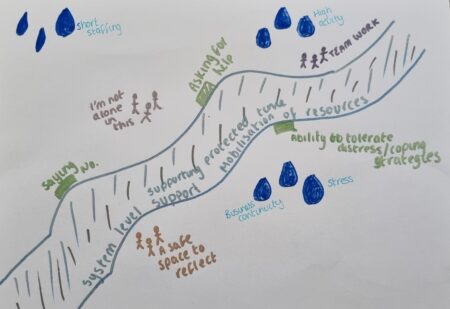Home News & Views How we can use ecosystems to think about resilience in a different way
How we can use ecosystems to think about resilience in a different way
 Grace Cook, FoNS Facilitator and RBCS Lead
Grace Cook, FoNS Facilitator and RBCS Lead
As the lead facilitator for Resilience-based Clinical Supervision (RBCS) programme at FoNS, resilience is a word I discuss a lot. I would like to start this blog by thanking Prof Gemma Stacy for opening an honest and reflective dialogue in her recent blog (if you haven’t read it I would urge you to!), which has encouraged me to talk openly and publicly about my own thoughts about resilience.
The most common definition of resilience that I have come across, both within discussions and research is ‘bouncebackability’ – an individual’s ability to recover from difficulties quickly or spring back into shape. This is one definition of resilience, but it is not the only one. My preferred definition, and the one we consider RBCS fits within, is the ecological definition of resilience. This definition does not just focus on the individual but a collective response to adversity (requiring diversity, mobilisation of resources and non-linear behaviours) (Stacey et al., 2020).
I recently watched Simon Reeves travel around the Lake District and one of the projects he visited stood out to me as an example of ecological resilience. Simon visited a project where the rivers in Cumbria are being ‘re-wiggled’ to slow the flow of water into the cities, allow the river to absorb more water, create habitats and allow better access to a flood plain. This is a great initiative which will hopefully reduce the risk of flooding to the local area. However, this on its own is not enough and it is part of the Cumbria Flood Action Plan. The action plan also includes strengthened defences, community flood hubs alongside other things because just re-wiggling the rivers in themselves would not be enough. Using different resources at different levels enables the development of a resilient ecosystem that works towards reducing the potential devastating impact of flooding. The action plan gives a lovely example of the mobilisation of resources at different levels for a really complex ecosystem.
So that is all well and good for ecosystems, but how does this relate to resilience in health and social care? Well, just like ecosystems, we live and work within complex environments and systems. Resilience interventions within these systems are often aimed towards an individual being taught skills of how to be resilient (Stacey and Cook, 2019). This could be seen as a strengthened defence if we relate this to flooding, great to have but on its own isn’t going to stop the river from bursting its banks if the water gets too high. What is really required is a mobilisation of different resources at different levels. In true FoNS fashion I thought I would share my thoughts creatively in a picture which I am calling the River of Resilience…

This shows the system level of prioritising support, protected time and a mobilisation of resources, a community level of teamwork and having a safe space to reflect and individual level of asking for help and individual coping strategies. These are by no means the only ways of supporting a resilient workforce, merely an indication of how resilience is not just one individual’s responsibility, rather, how all people at all levels have their own part to play.
I would love to hear your thoughts on this and be able to have an open and honest dialogue. As always please comment, email, or share your thoughts on social media.
Comments are closed.

